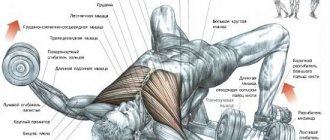A great way to tighten your figure and create a beautiful muscle definition is a set of static exercises. There are no sudden movements when performing, so static exercise is relatively safe for the joints and cardiovascular system. It adds variety to strength training and increases a person’s endurance.
Static or isometric exercises are based on tensing a muscle for a certain period of time. A great example is a simple plank that tightens the abdominal, back and buttocks in just 1 minute. By performing the complex 2-3 times a week, you can achieve beautiful shapes and remove fat deposits with minimal time and effort.
Why are static exercises needed and what do they develop?
Static
(isometric)
exercises
–
muscle
in which there is no movement, and the muscles are in a reduced state for a certain period of time.
Such training is suitable for developing
endurance, and with the correct construction of the training system, it can work all muscle groups.
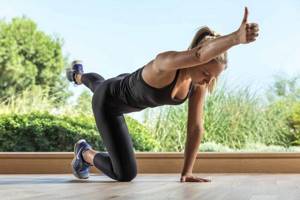
Static
holds are devoid of sudden movements, which eliminates excessive load, moreover, each of them involves only the use of one’s own body without additional devices and weights. Static exercises strengthen the connective tissue that surrounds the muscles and ligaments.
A set of exercises promotes:
- increasing control over body balance;
- development of back muscles and spinal alignment;
- involvement of slow muscle fibers
; - normalization of metabolism in cells.
Who is it suitable for?
Static exercises can be performed by absolutely everyone. The only obstacle can be personal contraindications given by the doctor. But in general, this complex is intended primarily for those people who have suffered any injuries or have illnesses that do not give them the opportunity to engage in fitness. This is also a real find for office workers. Without leaving your workplace, you can perform several loads and feel both lightness and strength in your body. So, now we suggest you learn how to perform static exercises at home by familiarizing yourself with the complex.
The benefits and harms of static exercises
Static exercises
very useful for today's busy schedule. They allow you to work out muscles that have been inactive for a long time, which has a strengthening effect and prevents atrophy.
Let's look at the positive and negative effects of isometric exercises.
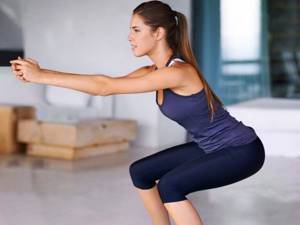
The benefits of this set of exercises are as follows:
- Ø strengthening muscle fibers and the spinal region;
- Ø burning subcutaneous fat, weight loss process;
- Ø targeted effect on specific muscles;
- Ø short execution time (10-20 minutes);
- Ø cellular energy is directed to the muscles without movement;
- Ø possibility of training without special training equipment;
- Ø gradual increase in strength
.
Negative effects of isometric exercises are also present:
- Ø the increase in strength occurs more slowly than with dynamic exercises
; - Ø for some people, after switching to statics, strength indicators deteriorate;
- Ø performing only static exercises increases tendons, but at the same time reduces the size of the active part of the muscle, which is most pronounced in adolescents;
- Ø poor development
of joint mobility; - Ø increase in blood pressure.
The note.
People over 50 years of age should consult a doctor before performing static exercises, as many of them increase the load on the cardiovascular
system
.
About the basis of strength
It often happens that at first glance, a small, fragile and even thin person easily surpasses pumped up massive athletes in battle and competitions. This is a clear example of how static strength exercises work. They develop power inside you, and not outside, and make it possible to hide under the face of a fragile person, in fact being a very dangerous adversary. In most cases, adherents of martial arts (which, in fact, are distinguished by fragile figures) perform statistical exercises as a warm-up. This complex allows you to concentrate, gather strength in the right place and throw it out at the right moment.
In general, we can say that these movements are performed with delays. If you need to burn fat, the delay is from 40 to 45 seconds, if you need starting preparation, 20-30 seconds.
A set of static exercises
During static training, you should focus on the target muscles, which will give the effect of pumping the whole body.
Static exercises for all muscles of the body
As before other workouts, for statics you need to warm up. For example
, the following warm-up movements are suitable: quick knee raises, burpees, light arm swings.
Plank
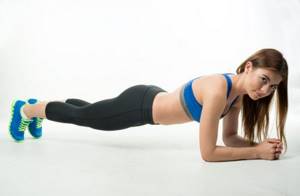
The plank is an exercise known to almost everyone that uses all the core and stabilizing muscles. Helps improve posture and pumps up core muscles.
To perform the exercise, place your forearms on the floor with the inner side, and your feet shoulder-width apart, a solid straight line should form. Performed in 3-4 sets of 20-60 seconds.
Many people hold the bar in such a way that a deflection is formed in the lower back. This change leads to the fact that the main load is more concentrated on the shoulders and lumbar region, and the core muscles remain almost unused. It is necessary to pull your stomach in and tense your abdominal muscles, bringing your body into a straight position.
Reference
. For people with lumbar hyperlordosis, it is necessary to perform only the RKC plank. There should be no deflection, the abdominal muscles should be as tense as possible, and the pelvis should be slightly raised.
Reverse plank
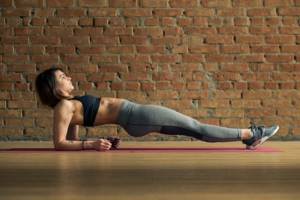
This option allows you to work your back muscles, quadriceps and shoulders.
To start, place your hands under your shoulders and your feet hip-width apart. Keep the spine in a level position, avoid sagging of the pelvis (the gluteal muscles are tense). The legs are straight, forming an even line with the body. Hold this pose for 30 seconds, perform 4 approaches.
Reverse plank on one leg

This exercise is a complication of the previous one. Designed for more trained people. The point is, after adopting the reverse plank position and clearly fixing it, raise one leg. An almost right angle should form.
The leg should be high. The lower its position, the more the load on the quadriceps femoris increases, which complicates the task and can lead to cramps in the limb. You need to perform 30 seconds, 1 approach on
each
leg.
Table
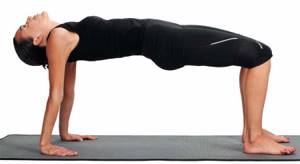
To perform this exercise, sit on the floor with your arms at your sides. After this, lift your pelvis to the top, your hands pointing in the same direction as your feet. A right angle should form at the knees. Make sure that the body is level and there are no bends. The buttocks and abs should be tense. Perform 2 sets of 30 seconds.
This exercise
can also be performed in
a dynamic
version - having assumed the “table” position, walk forward and backward.
One leg table
Take the position of the classic “table”, then raise your leg so that it continues the line of your torso. This complication makes you feel better about balance, and will also additionally load your hips and buttocks.
You should perform 1 approach with a duration of 40 seconds on each leg.
Staff
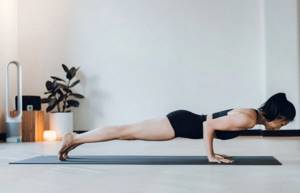
Staff pose is a branch of yoga. There it received the name Chaturanga Dandasana. Take a position on the floor as if you were doing push-ups. Avoid arching in the lower back. After this, lower yourself so that your body is parallel to the ground and the angle at your elbows is exactly 90º. Works well on the shoulders, pectoral muscles and some back muscles. Useful for weight loss.
It is recommended to perform 3 approaches lasting 15-20 seconds.
Slide
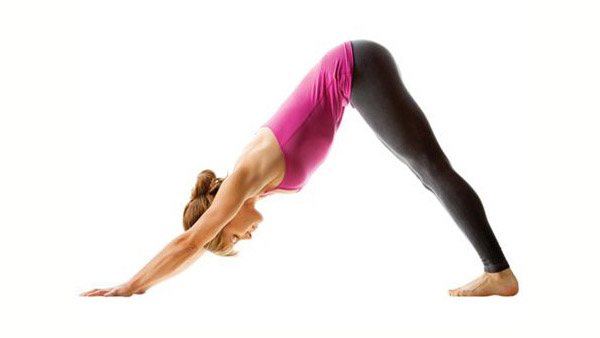
This exercise
aimed at stretching. The point is this. Place your feet shoulder-width apart. Lean forward, placing your palms completely on the floor, without bending your knees. If that doesn’t work, then take two identical books or something similar. Place them on the floor, placing your hands on them in a static bend.
Effective varieties of static exercises for legs and buttocks, abdominals and back
It is better to do static exercises for the legs, gluteal muscles, abs and back at home, since they will require a chair, a fitness mat and flat walls.
A set of exercises for the buttocks and leg muscles:
- standing near the wall, do a squat so that your back fits tightly against the wall, but does not lean on it. Your legs should be bent at the knees so that they form a right angle. You need to stay in this position for 30 seconds, then rise and let the muscles relax;
- For the gluteal muscles, you need to do exercises near a chair or table so as not to lose your balance. Grasping the back of the chair, lift your left leg back so that it forms a parallel line with the floor. Hold this position for half a minute, change legs and start all over again.
Complex for the abs and back:
- plank – you can lean on your palms or bend your elbows and lean on your forearm. Start holding for 30 seconds and gradually increase the time;
- corner - perform on the mat. Lying on the floor, begin to raise your straight legs and arms with your body until your body forms a right angle. Fix in this state for half a minute, then let the muscles relax and repeat;
- lying on the floor, bend your knees, arms along your body. Raise your pelvis so that your thighs and shins form a right angle. Hold the position for 30 seconds, then rest and repeat;
- get on all fours, raise your right leg and left arm. Having straightened them and raised your head, hold the position for 20 seconds, then switch arms and legs and repeat.
Types of statistical exercises
There are 3 types of isometric exercises:
1. When extreme muscle tension counters insurmountable resistance. 2. When performing a movement, stop for a couple of seconds, creating tension. 3. When an obstacle is created that stops the movement of the projectile.
Static exercises force the muscles to experience extreme tension during a certain phase of movement. Thanks to them, you increase the strength of muscles that are not very well developed.
Benefits of isometric exercises
Unlike dynamic training, static training trains strength for those poses in which you freeze, therefore, for comprehensive development it is necessary to rotate these poses. That is, dynamic exercises improve jerk strength, while isometric exercises develop overall strength. But besides this, statics have other advantages:
- Increases the strength of muscles and tendons
- Minimum time spent
- Short period of muscle recovery after training
- Training takes place anywhere
- Any durable projectiles can be used
- Develop flexibility
With regular training, you will strengthen your tendons and significantly increase the strength of your body.
Basic static exercises
Train anywhere and use anything. For example, you can push a wall, try to bend a metal rod or break a chain, use your imagination and come up with a bunch of options for training. Let's look at a few exercises for a better understanding:
- We use the doorway, rest our feet and hands on it and try to tear off the jamb
- We take a stick and try to twist it, simulating spinning clothes
- We are looking for two trees that are located close to each other, we rest our backs on one, and we push the other with our feet
These exercises can be performed at home or outdoors. The gym has equipment that allows you to do many more exercises, such as:
- Static leg press
- Static vertical traction
- Static deadlift
- Static squat
While performing, do not hold your breath, perform one exercise for no more than 12 seconds, rest for about half a minute between repetitions.
If you have never included statics in your training, then start with elementary movements, increasing the load as much as possible. Static exercises for developing strength will help you get into fantastic shape in a short period of time.
What you need to know about statics
In Greek, statics means balance. And statistical or isometric exercises are exercises that require keeping the body motionless due to the resistance of gravity.
The point of statics is to apply the maximum possible force. When trying to move a conditional bed, you will most likely move it and not apply maximum force, but if you try to move the KAMAZ, which is basically impossible to do, then you will spend the absolute maximum of your strength.


